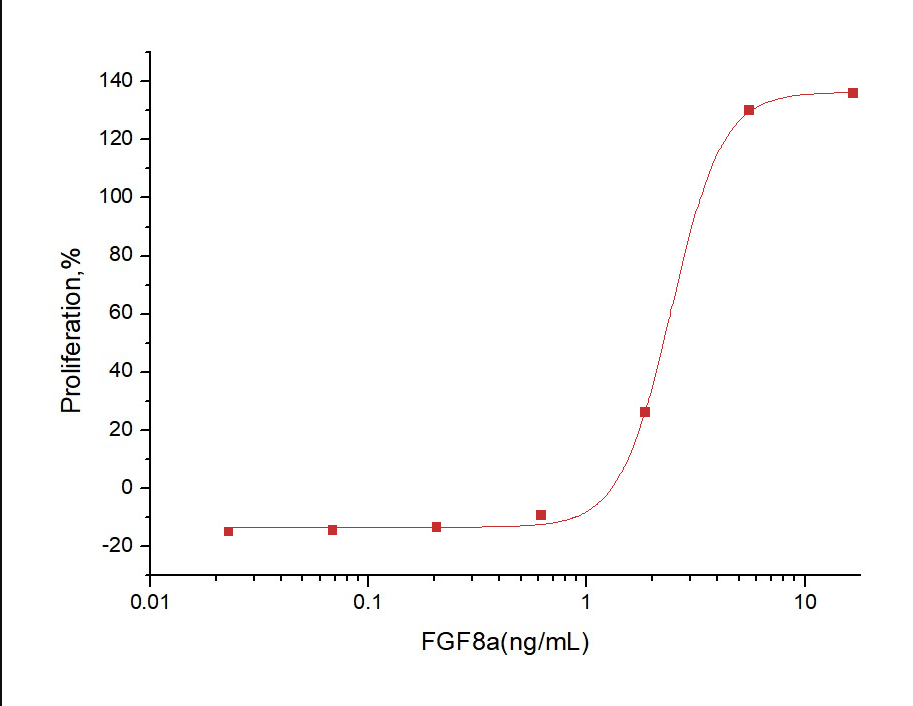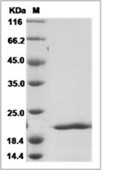Shopping Cart
- Remove All
 Your shopping cart is currently empty
Your shopping cart is currently empty

In mammalian embryos, transient Fgf8 expression defines the developing isthmic region, lying between the midbrain and the first rhombomere, but there has been uncertainty about the existence of a distinct isthmic segment in postnatal mammals. Retinoic acid (RA) directly represses Fgf8 through a RARE-mediated mechanism that promotes repressive chromatin, thus providing valuable insight into the mechanism of RA-FGF antagonism during progenitor cell differentiation. Fgf8 encodes a key signaling factor, and its precise regulation is essential for embryo patterning.

| Pack Size | Price | Availability | Quantity |
|---|---|---|---|
| 50 μg | $296 | In Stock | |
| 100 μg | $506 | 7-10 days | |
| 200 μg | $865 | 7-10 days | |
| 500 μg | $1,750 | 7-10 days |
| Biological Activity | Measured in a cell proliferation assay using BALB/c 3T3 mouse fibroblasts. The ED50 for this effect is typically 0.8-3.3 μg/mL.  |
| Description | In mammalian embryos, transient Fgf8 expression defines the developing isthmic region, lying between the midbrain and the first rhombomere, but there has been uncertainty about the existence of a distinct isthmic segment in postnatal mammals. Retinoic acid (RA) directly represses Fgf8 through a RARE-mediated mechanism that promotes repressive chromatin, thus providing valuable insight into the mechanism of RA-FGF antagonism during progenitor cell differentiation. Fgf8 encodes a key signaling factor, and its precise regulation is essential for embryo patterning. |
| Species | Human |
| Expression System | E. coli |
| Tag | Tag Free |
| Accession Number | P55075-2 |
| Synonyms | NEWENTRY,KAL6,HH6,HBGF-8,fibroblast growth factor 8 (androgen-induced),FGF-8,AIGF |
| Construction | A DNA sequence encoding the human FGF8a (NP_149355.1) (Gln23-Arg204) was expressed with an initial Met. Predicted N terminal: Met |
| Protein Purity | > 95 % as determined by SDS-PAGE.  |
| Molecular Weight | 21.3 kDa (predicted) |
| Endotoxin | Please contact us for more information. |
| Formulation | Lyophilized from a solution filtered through a 0.22 μm filter, containing 20 mM Tris, 500 mM NaCl, pH 8.5. Typically, a mixture containing 5% to 8% trehalose, mannitol, and 0.01% Tween 80 is incorporated as a protective agent before lyophilization. |
| Reconstitution | A Certificate of Analysis (CoA) containing reconstitution instructions is included with the products. Please refer to the CoA for detailed information. |
| Stability & Storage | It is recommended to store recombinant proteins at -20°C to -80°C for future use. Lyophilized powders can be stably stored for over 12 months, while liquid products can be stored for 6-12 months at -80°C. For reconstituted protein solutions, the solution can be stored at -20°C to -80°C for at least 3 months. Please avoid multiple freeze-thaw cycles and store products in aliquots. |
| Shipping | In general, Lyophilized powders are shipping with blue ice. |
| Research Background | In mammalian embryos, transient Fgf8 expression defines the developing isthmic region, lying between the midbrain and the first rhombomere, but there has been uncertainty about the existence of a distinct isthmic segment in postnatal mammals. Retinoic acid (RA) directly represses Fgf8 through a RARE-mediated mechanism that promotes repressive chromatin, thus providing valuable insight into the mechanism of RA-FGF antagonism during progenitor cell differentiation. Fgf8 encodes a key signaling factor, and its precise regulation is essential for embryo patterning. |

Copyright © 2015-2025 TargetMol Chemicals Inc. All Rights Reserved.